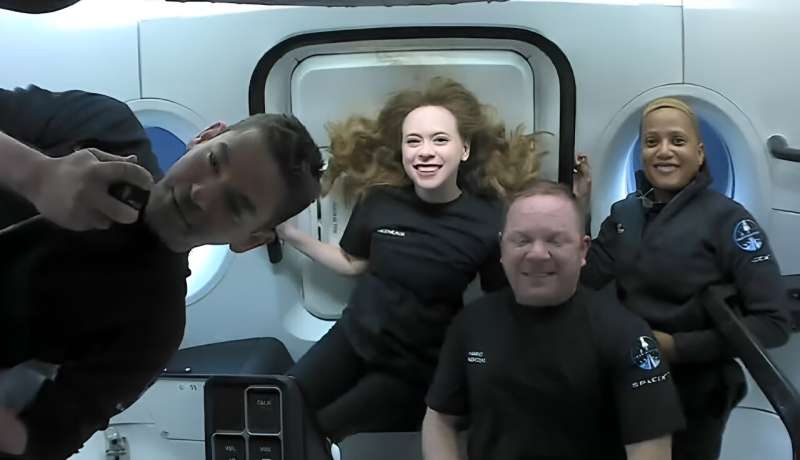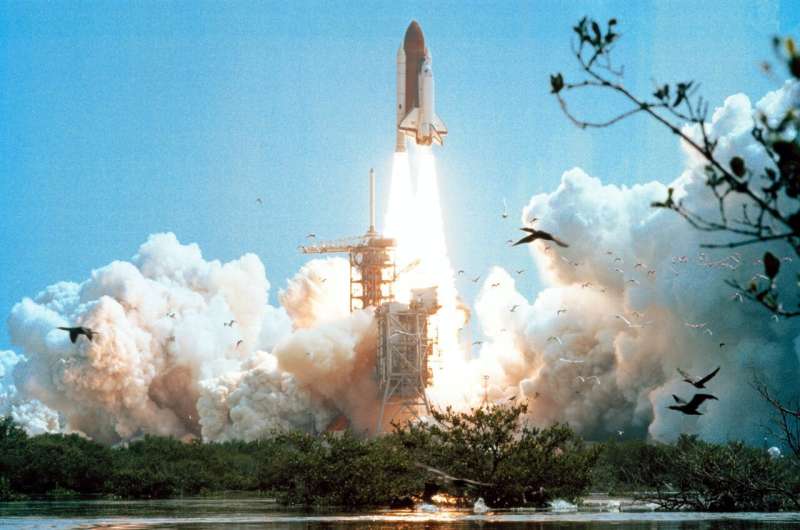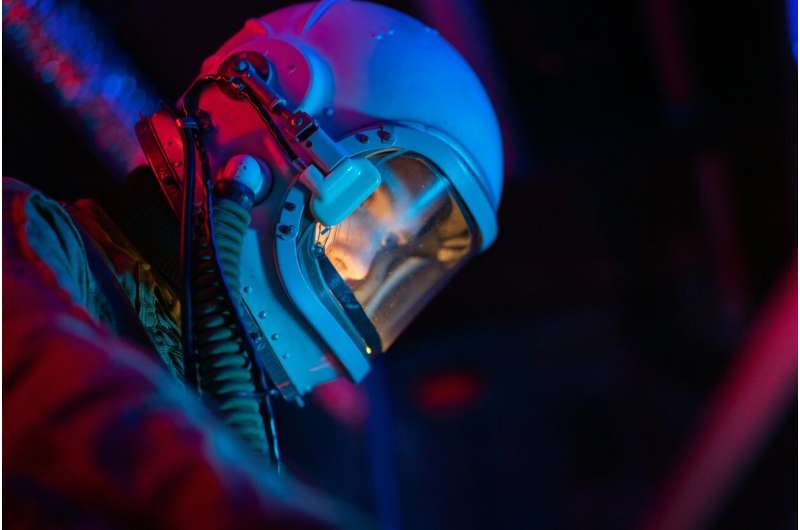
Copernical Team
Human bodies mostly recover from space, tourist mission shows

How bad for your health is space travel? Answering this question will be crucial not just for astronauts aiming to go to Mars, but for a booming space tourism industry planning to blast anyone who can afford it into orbit.
In what has been billed as the most comprehensive look yet at the health effects of space, dozens of papers were published on Tuesday using new data from four SpaceX tourists onboard the first all-civilian orbital flight in 2021.
Researchers from more than 100 institutions across the world sifted through the data to demonstrate that human bodies change in a variety of ways once they reach space—but most go back to normal within months of returning to Earth.
Researchers explore how the immune system goes awry during space travel and the implications for human aging on Earth

As long as humans have been traveling into space, astronauts have experienced significant health effects from the extreme conditions of space flight, notably the reduction of gravity.
Two Buck scientists led a team that has revealed for the first time how the lack of gravity affects the cells of the immune system at single cell resolution. The co-senior authors, along with Christopher E. Mason, Ph.D. of Weill Cornell Medical College, Associate Professor David Furman, Ph.D. and Associate Professor Daniel Winer, MD, have published an extensive survey of how gravity affects immune cells, and the identification of "space nutraceuticals" to counter aberrant effects of microgravity on these cells. The work is published in Nature Communications
"We show how simulated microgravity shapes immune cells and how the changes in force alter the cells' function at the single cell level," said Winer. "This level of resolution is new and exciting in understanding the effects of microgravity on cells."
Using cells in simulated microgravity, combined with data from space flight from astronauts and mice on the International Space Station, the researchers created a complete picture of how the different cells of the immune system in the peripheral blood are shaped by reduced gravity.
Would astronauts' kidneys survive a roundtrip to Mars?

The structure and function of the kidneys is altered by space flight, with galactic radiation causing permanent damage that would jeopardize any mission to Mars, according to a new study led by researchers from UCL.
The study, published in Nature Communications, is the largest analysis of kidney health in space flight to date and includes the first health dataset for commercial astronauts. It is published as part of a Nature special collection of papers on space and health.
Researchers have known that space flight causes certain health issues since the 1970s, in the years after humans first traveled beyond Earth's magnetic field, most famously during the first moon landing in 1969. These issues include loss of bone mass, weakening of the heart and eyesight, and development of kidney stones.
It is thought that many of these issues stem from exposure to space radiation, such as solar winds from the sun and Galactic Cosmic Radiation (GCR) from deep space, which the Earth's magnetic field protects us from on Earth. As most manned space flights take place in Low Earth orbit (LEO) and receive partial protection from Earth's magnetic field, only the 24 people who have traveled to the moon have been exposed to unmitigated GCR and only for a short time (six to 12 days).
China announces first astronaut candidates from Hong Kong, Macau

China on Tuesday announced the first astronaut candidates from its special administrative regions of Macau and Hong Kong, with the latter calling it a "glorious page" in the city's history.
Beijing has invested billions of dollars in its military-run space program as it pursues ambitious plans for a manned lunar landing by 2030.
The China Manned Space Agency said Tuesday that a payload specialist from Hong Kong and another from Macau were among 10 candidates for the country's fourth batch of astronauts.
Hong Kong leader John Lee called it "a glorious page in Hong Kong's history".
"This is... the first time that a Hong Kong citizen was selected as a payload specialist in China's manned space program, with a chance to become an astronaut to go to space in person, to participate in research and to contribute the country's space program," Lee said.
Sun Dong, Hong Kong's tech and innovation secretary, said the winning candidate was selected out of a pool of 120 applicants through a multi-round process that has been going on since 2022.
"We accepted a rather wide range of professional backgrounds including natural sciences, engineering, biology and medical science, because the space is a brand new area for scientific exploration," he told reporters, declining to name the Hong Konger selected.
Towards zero-debris CubeSats

In the past few years CubeSats revolutionised space applications in low Earth orbit, levelling the playfield and opening space to commercialisation, especially for smaller and medium companies. While their benefits are undeniable, a significant drawback is their potential to generate additional space debris. As the requirements for orbital lifetime and sustainability become more demanding, new challenges will arise for CubeSats. ESA is looking for innovative ideas to make the versatile satellites more sustainable.
AI on CubeSats Speeds Up Bushfire Detection
 Australian scientists are advancing in detecting bushfires quickly, using cube satellites equipped with AI that can identify fires from space 500 times faster than traditional ground-based methods.
Researchers have improved the processing and compression of large hyperspectral imagery on cube satellites. This technology, using AI, allows earlier detection of bushfires from space, enabling
Australian scientists are advancing in detecting bushfires quickly, using cube satellites equipped with AI that can identify fires from space 500 times faster than traditional ground-based methods.
Researchers have improved the processing and compression of large hyperspectral imagery on cube satellites. This technology, using AI, allows earlier detection of bushfires from space, enabling NASA Scientists Take to the Seas to Study Air Quality
 Satellites continuously peer down from orbit to take measurements of Earth, and this week a group of scientists set sail to verify some of those data points.
On June 2, the SCOAPE (Satellite Coastal and Oceanic Atmospheric Pollution Experiment) research team, in partnership with the U.S. Interior Department"s Bureau of Ocean Energy Management, took to the seas in the Gulf of Mexico for its
Satellites continuously peer down from orbit to take measurements of Earth, and this week a group of scientists set sail to verify some of those data points.
On June 2, the SCOAPE (Satellite Coastal and Oceanic Atmospheric Pollution Experiment) research team, in partnership with the U.S. Interior Department"s Bureau of Ocean Energy Management, took to the seas in the Gulf of Mexico for its Sentinel-5 Air Quality Instrument Ready for Installation
 Following months of testing, the Copernicus Sentinel-5 instrument has been delivered to Airbus in France for installation on the MetOp Second Generation weather satellite.
Sentinel-5, a Copernicus mission, will be carried on MetOp Second Generation A-type weather satellites, with the first launch expected in 2025.
The mission aims to measure atmospheric trace gases such as ozone, nit
Following months of testing, the Copernicus Sentinel-5 instrument has been delivered to Airbus in France for installation on the MetOp Second Generation weather satellite.
Sentinel-5, a Copernicus mission, will be carried on MetOp Second Generation A-type weather satellites, with the first launch expected in 2025.
The mission aims to measure atmospheric trace gases such as ozone, nit Earth and space share similar turbulence dynamics
 In a paper published in Geophysical Research Letters, researchers have discovered that turbulence in the thermosphere follows the same physical laws as wind in the lower atmosphere. Additionally, wind in the thermosphere rotates cyclonically-counterclockwise in the Northern Hemisphere and clockwise in the Southern Hemisphere.
These findings reveal a new principle for Earth's environmental
In a paper published in Geophysical Research Letters, researchers have discovered that turbulence in the thermosphere follows the same physical laws as wind in the lower atmosphere. Additionally, wind in the thermosphere rotates cyclonically-counterclockwise in the Northern Hemisphere and clockwise in the Southern Hemisphere.
These findings reveal a new principle for Earth's environmental Redwire to Develop Solar Arrays for Thales Alenia Space's New GEO Satellites
 Redwire Corporation (NYSE: RDW) announced it will develop and deliver Roll-Out Solar Array (ROSA) wings for Thales Alenia Space's Space Inspire satellites, the newest product line of geostationary (GEO) telecommunications satellites.
A joint venture between Thales (67%) and Leonardo (33%), Thales Alenia Space is a prime manufacturer providing space solutions for telecommunications, Earth o
Redwire Corporation (NYSE: RDW) announced it will develop and deliver Roll-Out Solar Array (ROSA) wings for Thales Alenia Space's Space Inspire satellites, the newest product line of geostationary (GEO) telecommunications satellites.
A joint venture between Thales (67%) and Leonardo (33%), Thales Alenia Space is a prime manufacturer providing space solutions for telecommunications, Earth o 
